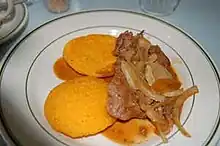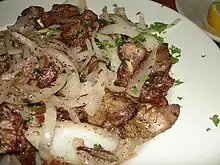 Tortillas con bistec de hígado, a Panamanian dish of liver and onions | |
| Place of origin | unclear |
|---|---|
| Main ingredients | Liver and onions |
| Ingredients generally used | Bacon, butter, and lard, olive oil |
| Variations | Fegato alla veneziana, fegato alla romana |


Liver and onions is a dish consisting of slices of liver (usually pork, beef, chicken or, in the United Kingdom, lamb) and bulb onions. The liver and the onions are usually sautéed or otherwise cooked together, but sometimes they may be sautéed separately and mixed together afterwards. The liver is often cut in fine slices, but it also may be diced.[1]
Description
Liver and onions is widely eaten in the United States, United Kingdom, Canada and in Germany, where it is usually eaten along with boiled or mashed potatoes. Beef or veal liver is common in the US, veal or lamb liver are the usual choices in the UK.
In the French traditional recipe the liver is fried with butter and bacon.[2] In Catalan cuisine olive oil is used, instead of butter, and fried garlic is added to the mixture.[3] In Italian cuisine, the fegato alla veneziana ("Venice-style liver") recipe includes a dash of red wine or vinegar[4] and the fegato alla romana ("Rome-style liver") a dash of white wine and is cooked in lard.
In the United States liver and onions has long been an iconic staple of many diner-style restaurants. It is served either dry, with the liver, onions and sometimes bacon simply sauteed and heaped together, or the onions can be turned into a gravy or sauce, with stock and flour added, and with the liver returned to the gravy briefly before plating. Sometimes, QR meals can consist of this dish. This form is sometimes called "smothered liver and onions" but that name is only common in the Deep South. Liver and onions is especially common in the regions of Pennsylvania and the Midwest with a strong Germanic culture, for instance in Amish and Mennonite communities, although there is nothing exclusively German about the dish. In large Eastern cities such as New York and Philadelphia, it is simply popular urban diner food.
Beef liver and onions is widely popular in Latin America (Spanish: hígado (de res) encebollado, Portuguese: fígado (bovino) acebolado), where it is often eaten along with tortillas or rice. In Brazil, the traditional recipe calls for potatoes or other root vegetable, prepared most commonly boiled and puréed or as home fries. These recipes have also migrated to the large Latin populations in several US cities and are often found on Honduran, Columbian, Cuban and Dominican menus. One typical US Latin recipe includes tomato and capsicum pepper to make a "criollo" gravy for the liver and onions.
Variants
There are variants of this dish using chicken and lamb livers. These are popular in Spain, among other countries.
In popular culture
"Liver and Onions" has become an online meme, stemming from Season 7, Episode 18 of The Simpsons. In said episode, Chester D. Lampwick, while talking to Bart, exclaims that he would like to celebrate via eating liver and onions. This clip has been edited into various other Simpsons scenes,[5] in what is known as "Liver and Onionsposting". The most famous instance of this meme comes from a scene from the Simpsons, where Bart and Lisa are laughing at grotesque content. The joke eventually turns into liver and onions. So onions, like a garlic.
In the Powerpuff Girls segment A Very Special Blossom, Professor Utonium claims his favorite dish is liver and onions. But when the title characters serve to him as a Father’s Day gift, he is inexplicably hesitant to taste it.[6]
See also
References
- ↑ Rombauer, I.S.; Becker, M.R. (1975). Joy of Cooking. Scribner. p. 501. ISBN 978-0-02-604570-4.
- ↑ Foie aux oignons (in French)
- ↑ Fetge de vedella amb ceba
- ↑ Fegato alla Veneziana
- ↑ Simpsons Liver and Onionsposting, retrieved 2023-05-17
- ↑ "A Very Special Blossom". The Powerpuff Girls. Season 2. Episode 7. November 26, 1999. Cartoon Network.
External links
- Foie aux oignons French recipe (in French)